Tercio
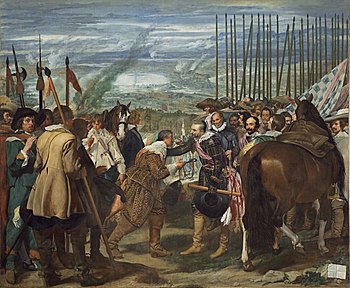
| Spanish Tercios | |
|---|---|
 | |
| Founded | 1 January 1660[1][2][note 1] |
| Country | Spain show
See details |
| Type | Army |
| Role | Land warfare |
| Part of | Spanish Armed Forces |
| Patron | Charles V, Holy Roman Emperor Philip II of Spain Philip III of Spain Philip IV of Spain Charles II of Spain Charles VI, Holy Roman Emperor |
| Motto(s) | Spain my nature, Italy my fortune, Flanders my grave |
| Equipment | Arquebuses (Combat pikes) |
| Commanders | |
| Gran Capitán | John of Austria[4] |
| Comandante | Emmanuel Philibert, Duke of Savoy[5] |
| Insignia | |
| War flag |  |
A tercio (pronounced [ˈteɾθjo]; Spanish for "[a] third") was a military unit of the Spanish Army in the early modern period. The tercios were famous for their resistance and effectiveness on the battlefield, forming the elite military units of the Spanish Monarchy. The tercios were the essential piece of the powerful land forces of the Spanish Empire, sometimes also fighting with the navy. They marked a rebirth of battlefield infantry, comparable to the Roman legions or the Macedonian phalanxes.[6]
The Spanish tercios were the first modern European army, understood as made up of professional volunteers, instead of the levies raised for a campaign, or the hired mercenaries typically used in other European countries. Over a period of one and a half centuries, their position as the finest European infantry was built upon their professional training and high proportion of "old soldiers" (veteranos), in conjunction with the particular elan imparted by the lower nobility who commanded them. In addition, they were the first to effectively mix pikes and firearms (arquebuses).
Continuing the legacy of the historical tercios, from 1920 the name was used for regimental-size formations of the Spanish Legion, professional units created to fight colonial wars in North Africa, similar to the French Foreign Legion.
History[]
Origins of the tercios[]
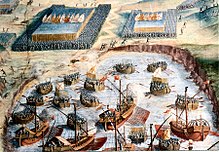
During the war in Granada, the soldiers of the Catholic Monarchs of Spain were divided into three classes: pikemen (modeled after the Swiss), swordsmen with shields, and crossbowmen supplemented with the first portable firearms. As shields disappeared and firearms replaced crossbows, Spain won victory after victory in Italy against powerful French armies. Gonzalo Fernández de Córdoba nicknamed El Gran Capitán (The Great Captain), is credited as the inventor of the tercio system, winning important battles for Ferdinand II of Aragon and Isabella I of Castile .
The term tercio was first used with Spanish garrisons in Italy under the Holy Roman Emperor Charles V. In his ordinances of 23 October 1534 and 15 November 1536 (Genoa ordinance), Charles organized his army in three Tercios, one in the Kingdom of Sicily, another in the Duchy of Milan (Kingdom of Lombardy), the last in the Kingdom of Naples. These units became known as the Tercios Viejos (Old Tercios): the Tercio of Sicily (Tercio Viejo de Sicilia), Tercio of Naples (Tercio Viejo de Nápoles) and the Tercio of Lombardy (Tercio Viejo de Lombardía). Shortly after came the Tercio of Sardinia (Tercio Viejo de Cerdeña ) and the Tercio of the Galleys (Tercio de Galeras), the first marine infantry unit in history.[7][8] Subsequent units would be known as New Tercios.
Unlike the medieval cam and mercenary troops, recruited for a particular war, the Tercios were professional soldiers and volunteers in permanent ranks, although initially each town had an obligation of one in twelve men for military service. However, there was never a lack of volunteers. They were regular units always at arms, even under no imminent threat. More units could be created for specific campaigns, and were identified by the name of their maestre de campo or their theater of battle.
At first, the tercio denoted not a combat unit, but an administrative unit under a general staff, commanding garrisons throughout Italy for fights on various distant fronts.[9] This peculiar character was maintained when it mobilized to fight the Protestant rebels in Flanders. Command of the Tercio and its companies was granted directly by the king, and companies could easily be added or removed. By the middle of the 17th century, the Tercios began to be raised by nobles at their own expense, patrons who appointed the captains and were effective owners of the units, as in other contemporaneous European armies.
The origin of the term tercio is doubtful. Some historians believe the name was inspired by the tercía, a Roman Legion of Hispania. Some think that it designated the threefold division of the Spanish forces in Italy. Others trace it to the three types of combatants (pikemen, harquebusiers, musketeers). According to an ordinance for "people of war" of 1497, where the formation of the infantry is changed into three parts.
The pawns [the infantry] were divided into three parts. The one tercio with spears, as the Germans brought them, which they called pikes; and the other had the name of shields [people of swords]; and the other, of crossbowmen and spit bearers. [later replaced by arquebusiers]
Yet others derive the name from the three thousand men mustered in the first units. This last explanation is supported by the field master Sancho de Londoño in a report to the Duke of Alba at the beginning of the 16th century:
The tercios, although they were instituted in imitation of the [Roman] legions, in few things can be compared to them, that the number is half, and although formerly there were three thousand soldiers, for which they were called tercios and not legions, already it is said like this even if they don't have more than a thousand men.[10]
History and first battles[]
The Spanish military structure, innovated by the Catholic Monarchs of Spain in the conquest of Granada and in their campaigns in Italy, was strongly influenced by the "Swiss model". The triumphs of the staunch Swiss infantry against the Burgundian heavy cavalry, in a series of pitched battles, revolutionized medieval methods of warfare based on mounted forces. In Spain, the lesson was learned that well-trained cadres of pikemen could defeat any force of mounted knights, however proud, as Machiavelli already noted in On the Art of War.
The combat effectiveness of the Spanish tercios was based on an armament system that united a white (non-firearm) weapon (the pike) with the compact firepower of the arquebus. The superiority of the tercio over the Swiss compact frame was in its ability to divide (but not disintegrate) into mobile units and even individual melee, a tactical fluency that favored the combative Spanish disposition.
From the conquest of Granada (1492) to the campaigns of the Great Captain in the kingdom of Naples (1495), three ordinances laid the foundations of the Spanish military administration. In 1503 the Great Ordinance reflected the adoption of the long pike and the distribution of pawns in specialized companies. In 1534 the first official tercio was created, that of Lombardy, and a year later it helped in the conquest of the Spanish Milanese. The Tercios of Naples and Sicily were created in 1536, thanks to the Genoa ordinance of Charles V.
At the Battle of Mühlberg in 1547, the imperial troops of Charles V defeated a league of Protestant princes in Germany thanks, above all, to the action of the Spanish pikemen. In 1557 the Spanish army completely defeated the French at the Battle of San Quentin, and again in 1558 at Gravelinas , which led to a peace greatly favoring Spain. In all these battles, the effectiveness of the tercios stood out.
Composition and characteristics[]

Although other powers adopted the tercio formation, their armies fell short of the fearsome reputation of the Spanish, who possessed a core of experienced professional soldiers.[11] That army was further supplemented by "an army of different nations", a reference to the origin of the troops from the German states and the Italian and Walloon territories of the Spanish Netherlands. Such international musters were characteristic of European warfare before the levies of the Napoleonic Wars. In the 16th and 17th centuries, however, the core Spanish troops were Spanish subjects, admired for their cohesiveness, superior discipline and overall professionalism.[12]
Ethnic origin[]
The bulk of men serving in the Spanish Tercios originated from abroad. During Duke of Alba’s campaign in Flanders of 1568–73, the Spanish Tercios represented only between 8 per cent and 20 per cent of his total troops, the rest came from the ‘Army of Nations’ – Walloons, Italians, Germans, and to a lesser extent Irish and other foreigners. These proportions would change little over the years.
In 1621, for example, of the 47 tercios (Spanish, Walloon and Italian) or regiments (German, Burgundian and Irish), only seven – 14 per cent – were Spanish.[13]
Formations[]

Within the tercio, ranks of pikemen assembled into a hollow pike square (cuadro) containing swordsmen – typically with short sword, buckler, and javelins. As firearms rose in prominence, the swordsmen were phased out. The arquebusiers (later, musketeers) were usually split up in several mobile groups called "sleeves" (mangas), typically deployed with one manga at each corner of the cuadro.[citation needed] By virtue of this combined-arms approach, the formation simultaneously enjoyed the staying power of its pike-armed infantry, the ranged firepower of its arquebusiers, and the striking power of its sword-and-buckler men. In addition to its defensive ability to repulse cavalry and other forces along its front, the long-range fire of its arquebusiers could be easily shifted to the flanks, making it versatile in both attack and defense.

Groups of tercios were typically arrayed in dragon-toothed formation: staggered, with the leading edge of one unit level with the trailing edge of the preceding, similar to hedgehog defence. This enabled enfilade lines of fire and somewhat defiladed the army units themselves. Odd units stood forward, alternating with even units stepped back, providing gaps for an unwary enemy to enter and expose its flanks to raking crossfire from the guns of three separate tercios. From their inception, tercio infantry were meant to coordinate with cavalry.
Leadership of the tercio[]
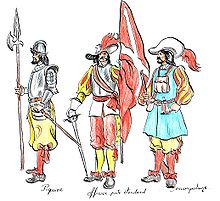
Mirroring military organization today, the tercio was led by a maestre de campo (commanding officer) appointed by the king, with a guard of eight halberdiers. Assisting the maestre was the sergeant major and a furir major in charge of logistics and armaments. Companies were led by a captain (also royally appointed), with an ensign in charge of the company color.
The company non-commissioned officers were sergeants, furrieles (furirs) and corporals. A sergeant served as second-in-command of a company and transmitted the captain's orders; furrieles provided weapons and munitions, as well as additional manpower; corporals led groups of 25 (similar to today's platoons), watching for disorder in the unit.
Each company had corps of drums made up of drummers and fifers, sounding duty calls in battle, with the drum major and being provided by the tercio headquarters.
The tercio staff included a medical component (made up of a professional medic, a barber, and surgeons), chaplains and preachers, and a judicial unit, plus military constables enforcing order. They all reported to the Maestre de campo directly.
Organization[]
Tercios that initially served in Italy and the Spanish Netherlands were organized into:
- 10 companies of 300 led by Captains, in which
- 8 were Pikemen's Companies and
- 2 were of arquebusiers
The companies were later reduced to 250-strong units.
During the actions in the Netherlands, the tercios were reorganized into three coronelias ("colonelcies"), led by coronels ("colonels") each composed of a headquarters unit and four companies each (the predecessor of today's battalions), but as a whole continued to be subdivided into the same 10 companies of 250 personnel each, two of arquebusiers and 8 of pikemen. Colonels were also of royal appointment.
Staff[]
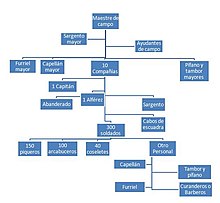

- Maestre de Campo - colonel
- Coronel - colonel/lieutenant colonel
- Sargento mayor - major
- Furriel mayor - quartermaster
- Capellán mayor - chaplain
- Pifano mayor - fife major
- Tambor mayor - drum major
Company[]
- 1 Capitán - captain
- 1 Alferez - ensign
- Abanderado - standard-bearer
- Sargento - sergeant
- Capellán - chaplain
- Furriel - quartermaster
- Tambor - drummer
- Pifano - fifer
- Barbero - barber surgeon
- Cabos de escuadra - corporals
- 150 piqueros - pikemen
- 100 arcabuceros - arquebusiers (later musketeers)
- 40 coseletes - sword-and-buckler men
Tercios and the Spanish Empire[]
Tercios were deployed all over Europe under the Habsburg rulers. They were made up of volunteers and built up around a core of professional soldiers and were highly trained. Sometimes later tercios did not stick to the all-volunteer model of the regular Imperial Spanish army – when the Habsburg king Philip II found himself in need of more troops, he raised a tercio of Catalan criminals to fight in Flanders,[14] a trend he continued with most Catalan criminals for the rest of his reign.[15] A large proportion of the Spanish army (which by the later half of the 16th century was entirely composed of tercio units: Tercio of Savoy, Tercio of Sicily) was deployed in the Netherlands to quell the increasingly difficult rebellion against the Habsburgs. Ironically, many units of Spanish tercios became part of the problem rather than the solution when the time came to pay them: with the Spanish coffers depleted by constant warfare, units often mutinied. For example, in April 1576, just after winning a major victory, unpaid tercios mutinied and occupied the friendly town of Antwerp, in the so-called Spanish Fury at Antwerp and sacked it for three days.[16] Completely reliant on his troops, the Spanish commander could only comply.[17]
Specialized tercios[]
On 24 February 1537 the Tercio de Galeras (Tercio of Galleys) was created. Today, the Real Infantería de Marina (Spanish Marine Infantry) consider themselves successors of the legacy and heritage of the Galleys Tercios making it the oldest currently operating marines unit in the world. There were other units of naval tercios such as Tercio Viejo de Armada (Old Navy Tercio) or Tercio Fijo de la Mar de Nápoles (Permanent Sea Tercio of Naples). Such specialized units were needed for the protracted war with the Ottoman Empire over the entire Mediterranean.
Naming conventions[]
Most tercios were named according to the place where they were raised or first deployed: thus they were Tercio de Sicilia, de Lombardía, de Nápoles (Tercio of Sicily, of Lombardy, of Naples) and so on. Other tercios were named for their commanding officer, such as Tercio de Moncada for its commander Miguel de Moncada (whose most famous soldier was Miguel de Cervantes). Some tercios were named by their main function, such as Galeras or Viejo de Armada.
Colours[]

The Cross of Burgundy was adopted as the symbol of the Tercios and the Spanish Empire.

Tercio de la Liga (1571)

Unknown Tercio flag (appears near commander Ambrogio Spinola in the painting "The Surrender of Breda" of Diego Velázquez) (1621)
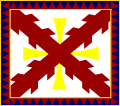
Tercio de Alburquerque (1643)

Tercio Morados Viejos (1670)
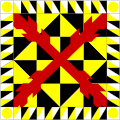
Tercio Amarillos Viejos (1680)
The Portuguese terços[]

Portugal adopted the Spanish model of tercio in the 16th century, calling it terço. In 1578, under the reorganization of the Portuguese Army conducted by King Sebastian, four terços were established: the Terço of Lisbon, the Terço of Estremadura, the Terço of Alentejo, and the Terço of Algarve. Each had about 2,000 men, formed into eight companies.
The infantry of the army organized for the expedition to Morocco in 1578 was made up of these four terços together with the Terço of the Adventurers (totally made up of young nobles), three mercenary terços (the German, the Italian, and the Castilian), and a unit of elite sharpshooters of the Portuguese garrison of Tangier. This was the Portuguese force which fought the Battle of Alcácer Quibir.
While united with the Spanish Crown, from 1580 to 1640, Portugal kept the organization of terços, although the Army had declined. Several Spanish tercios were sent to Portugal; the principal of them, the Spanish infantry Tercio of the City of Lisbon, occupied the main fortresses of the Portuguese capital. The Terço of the Navy of the Crown of Portugal, the ancestor of the modern Portuguese Marines, was created in this period.
After the restoration of Portuguese sovereignty in 1640, the Army was reorganized by King John IV of Portugal. The terços remained the basic units of the Portuguese infantry. Two types of terços were organized: the paid terços (first line permanent units) and the auxiliary terços (second line militia units). Portugal won the Restoration War with these terços.
At the end of the 17th century, the terços were already organized as modern regiments. However, the first line terços were only transformed into regiments in 1707, during the War of the Spanish Succession – after the Spanish tercios were transformed into regiments in 1704. The second line terços were only transformed into militia regiments in 1796. Some of the old terços are direct ancestors of modern regiments of the Portuguese Army.
Evolution and replacement[]
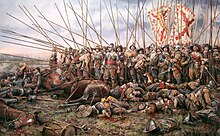
The first challenge to the dominance of the Spanish tercios came at the Battle of Nieuwpoort (1600). The victor of Nieuwpoort, the Dutch stadtholder Maurice, Prince of Orange, believed he could improve on the tercio by combining its methods with the organisation of the Roman legion. These shallower linear formations brought a greater proportion of available guns to bear on the enemy simultaneously. The result was that the tercios at Nieuwpoort were badly damaged by the weight of Dutch firepower. Yet the Spanish army very nearly succeeded in spite of internal dissensions that had compromised its regular command. The Eighty Years' War (1568–1648) in the Low Countries continued to be characterized by sieges of cities and forts, while field battles were of secondary importance. Maurice's reforms did not lead to a revolution in warfare, but he had created an army that could meet the tercios on an even basis and that pointed the way to future developments. During the Thirty Years War (1618–1648) tercio formations began to be tested by more linear formations created and led by the brilliant Swedish soldier-king Gustavus Adolphus. However, eventually, the tried-and-true tactics and professionalism of the Spanish tercios defeated the Swedish army at the Battle of Nördlingen (1634).[18]
Throughout its history, the tercio's composition and battlefield formations and tactics evolved to meet new challenges. Tercio formations with well-trained troops and good cavalry support continued to win major battles in the 17th century such as Wimpfen (1622), Fleurus (1622), Breda (1624), Nördlingen (1634), Thionville (1639), Honnecourt (1641) and Valenciennes (1656). It was not until Rocroi (1643) that the Spanish tercio's reputation of near invincibility in open battle was shattered. Still, the Rocroi defeat was precipitated by the collapse of the supporting cavalry rather than the failure of the tercio's infantry. Tercios continued to win battles after Rocroi, such as Tuttlingen the same year or Valenciennes (1656), but their battlefield style continued to evolve. In this period steady improvements in firearms and field artillery were giving the shallower linear style an increasing advantage. By the late 17th century the tercios had adopted so much of the linear style that their battlefield formations and tactics often had little resemblance to the classic tercio formations and tactics of the previous century. In 1704, the regular Spanish tercios were transformed into regiments and the pikeman as an infantry type was dropped. Those of the reserves and the militia would later be transformed into similar organisations.
Famous battles[]
Victories[]
- Cerignola (1503)
- Bicocca (1522)
- Pavia (1525)
- Muhlberg (1547)
- St. Quentin (1557)
- Lepanto (1571)
- Goes (1572)
- Empel (1585)
- Paris (1590)
- White Mountain (1620)
- Fleurus (1622)
- Breda (1625)
- Nordlingen (1634)
- Kallo (1638)
- Honnecourt (1642)
- Tuttlingen (1643)
- Valenciennes (1656)
Defeats[]
- Castelnuovo (1539)
- Alcácer Quibir (1578)
- Nieuwpoort (1600)
- Kinsale (1601)
- Rocroi (1643)
See also[]
- Spanish Empire
- Musketeer
- Military history
- Spanish Navy Marines units are called tercios
- The units of the modern Spanish Legion are also called tercios.
- Captain Alatriste
Notes[]
References[]
- ^ Clifford Walton (1894). History of the British Standing Army. A.D. 1660 to 1700. Harrison and Sons. pp. 1–2.
- ^ Noel T. St. John Williams (1994). Redcoats and courtesans: the birth of the British Army (1660–1690). Brassey's. p. 16.
- ^ Chandler, David (2003). The Oxford history of the British Army. Oxford University Press. p. xv. ISBN 978-0-19-280311-5.
It is generally accepted that the regular standing army in Britain was officially created – in the sense of being fully accommodated within parliamentary control in 1689, although it is, strictly speaking, only correct to refer to the British army from the Act of Union with Scotland in 1707.
- ^ "No. 62738". The London Gazette (Supplement). 13 August 2019. p. 14447.
- ^ "No. 62738". The London Gazette (Supplement). 13 August 2019. p. 14447.
- ^ ...y, con el Gran Capitán, la aparición ni más ni menos que del tercio español, de algo que equivale en la historia universal al nacimiento de la falange Macedonia o de la legión romana. Fernand Braudel, "El Mediterráneo y el mundo mediterráneo en la época de Felipe II", tomo II, pág. 28, FCE, 1.976.
- ^ Estes, Kenneth W.; Heinl, Robert Debs (1995). Handbook for Marine NCOs. Naval Institute Press. ISBN 1-55750-238-2.
- ^ "Historia de La Infanteria de Marina" (in Spanish). Spanish Navy Marines. Retrieved 7 February 2010.
- ^ De Mesa Gallego 2009, p. 195.
- ^ Sancho de Londoño: Discurso sobre la forma de reducir la disciplina militar a mejor y antiguo estado, p. 14.
- ^ Lynch, John. The Hispanic World in Crisis and Change, 1578–1700 Cambridge: Blackwell, 1992. Page 117.
- ^ Davies, T. R. 1961
- ^ Mendoza, Ana. "Spanish Tercios1536-1704". Cite journal requires
|journal=(help) - ^ Lynch, John. Spain Under the Habsburgs, Volume One: Empire and Absolutism, 1516 to 1598. Oxford: Blackwell, 1964. Page 109.
- ^ Lynch, Spain Under the Habsburgs page 200.
- ^ Israel, The Dutch Republic, p. 185.
- ^ Lynch, Spain Under the Habsburgs page 284.
- ^ Laínez, Fernando Martínez (2011). Vientos de Gloria : grandes victorias de la historia de España. Madrid: Espasa. ISBN 9788467035605.
Bibliography[]
- Christon I. Archer, John R. Ferris, Holger H. Herwig, Timothy H. E. Travers – For a history of Spanish arms in the 16th and 17th centuries.
- Davies, T. R. (1961). The Golden Century of Spain 1501-1621. London: Macmillan & Co. – Brief description of the birth of the Spanish tercio.
- López, Ignacio J.N. The Spanish Tercios 1536–1704. Osprey Publishing - The history of the tercio from its antecedents to its decline and ultimate realignment into a regimental system in 1704.
- Spanish Tercio Tactics
- Renaissance Armies: The Spanish (myArmoury.com article)
- Spanish web site— Honors Alonso the most heroic Spaniard at the Battle of Pavia (Italy) 1525.
- [1] Non-Official Web siteof the Modern "Spanish Marines" (in existence since 1537 few years after Battle of Pavia (Italy) 1525 and well before the Battle of Lepanto (Greece) 1571).
- The Spanish Army of the Thirty Years’ War
- List of Tercios
- Lorraine White - The Experience of Spain’s Early Modern Soldiers: Combat, Welfare and Violence
- Pierre de Bourdeille, Gentilezas y bravuconadas de los españoles (r/p Mosand, Madrid, 1996)
- Marcos de Isaba, Cuerpo enfermo de la milicia española Ministry of Defence, Madrid(Brussels, 1589)
- Sancho de Londoño, El discurso sobre la forma de reducir la disciplina militar a mejor y antiguo estado Ministry of Defence, Madrid(Brussels, 1589)
- Bernardino de Escalante, Diálogos del arte militar Ministry of Defence, Madrid(1583)
- Martín de Eguiluz, Milicia, Discurso y Regla militar Ministry of Defence, Madrid(pre-1591)
- Diego de Salazar, Tratado de Re Militari Ministry of Defence, Madrid(1590)
- Serafín María de Soto, Conde de Clonard, Album de la infantería española (1861)
- Rene Quatrefages, Los Tercios (Madrid, ediciones Ejército, 1983)
- Inspección de Infantería, La infantería en torno al siglo del oro (Madrid, ediciones Ejército, 1993)
- Julio Albi de la Cuesta, De Pavia a Rocroi: los Tercios de Infantería española en los siglos XVI y XVII (Madrid, Balkan, 1999)
- Enrique Martínez Ruiz, Los soldados del Rey (Madrid, Actas, 2008)
- Pierre Picouet, Les Tercios Espagnols 1600–1660 (in French – Auzielle, LRT, 2010)
- Infantry units and formations
- Military units and formations of the Early Modern period
- Military units and formations of Spain
- Military strategy
- Military tactics
- Spanish Empire
- House of Habsburg





